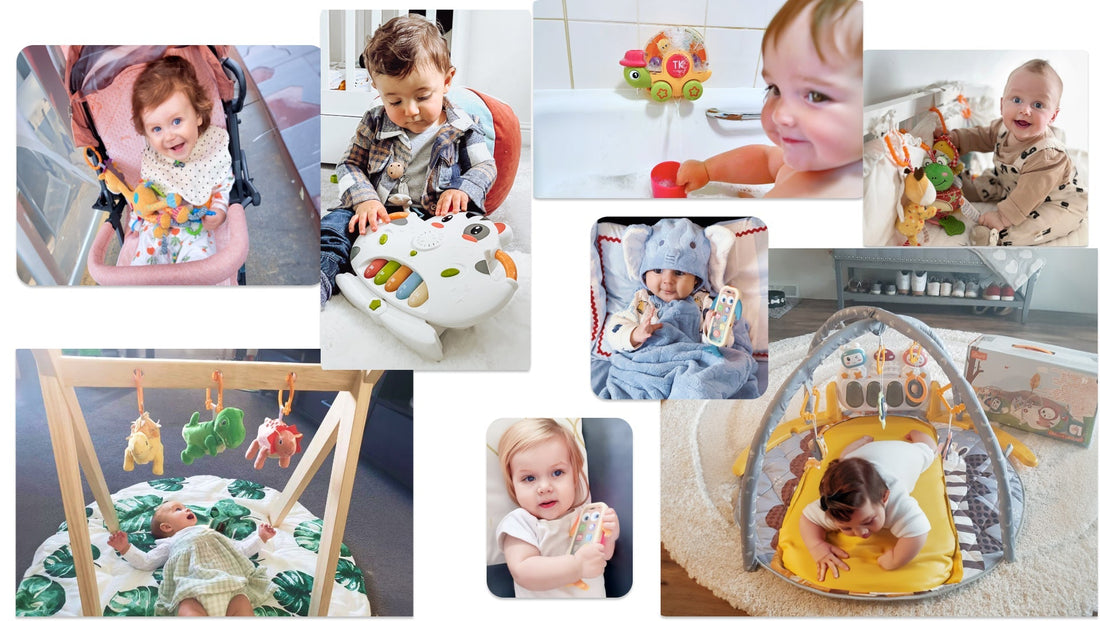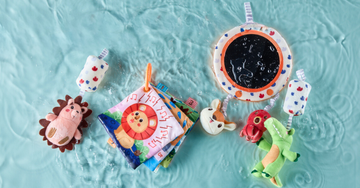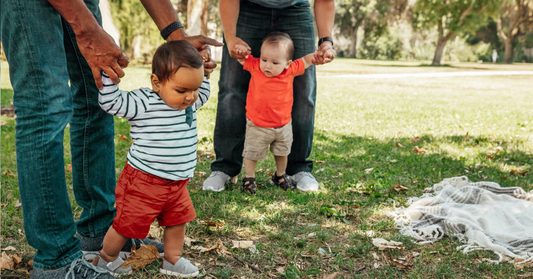아기는 언제 장난감을 가지고 놀기 시작합니까?

멋진 부모가 되는 여정에 오신 것을 환영합니다! 아이가 성장하고 배우는 모습을 지켜보는 것은 인생에서 가장 큰 기쁨 중 하나입니다. 초보 부모로서 아기의 발달에 대해 궁금한 점이 많으실 텐데, 그중 하나가 바로 "아기는 언제부터 장난감을 가지고 놀기 시작하나요?"입니다.
놀이는 아기의 성장에 매우 중요한 부분으로, 아기가 세상을 탐험하고, 필수적인 기술을 발달시키고, 부모와 유대감을 형성하는 데 도움을 줍니다. 이 가이드에서는 아기가 일반적으로 언제 장난감을 가지고 놀기 시작하는지, 각 발달 단계에 가장 적합한 장난감은 무엇인지, 그리고 장난감이 아이의 신체적, 인지적, 정서적 발달을 어떻게 지원하는지 알아보겠습니다.
아기가 장난감으로 놀기 시작하는 시기와 발달 단계
출생부터 3개월까지: 관찰 및 탐색
생후 첫 몇 달 동안 아기는 새로운 세상을 탐험하는 데 집중합니다. 근시인 아기는 얼굴, 고대비 무늬, 그리고 가까이 있는 물체에 가장 큰 관심을 보입니다. 이 단계에서는:
- 주요 이정표: 반사적으로 움켜쥐고, 눈으로 물체를 추적하고, 소리에 반응합니다.
- 시도해 볼 장난감: 부드러운 딸랑이, 고대비 모바일, 흑백 무늬의 장난감, 질감이 있는 원단.
- 놀이 아이디어:
- 아기의 얼굴에서 약 8~12인치 떨어진 곳에 장난감을 잡고 천천히 움직여서 시선이 아기의 얼굴과 마주치도록 하세요.
- 배 시간 목과 팔 근육을 강화하기 위한 질감이 있는 매트입니다.
- 아기의 얼굴 표정을 과장해서 말하고, 사회적 유대감을 형성하세요.
3~6개월: 닿고 잡기
이 단계에서 아기들은 팔과 손을 더 잘 다루기 시작합니다. 장난감을 잡으려고 손을 뻗고, 잡고, 입으로 가져가서 탐색합니다.
- 주요 이정표: 시력이 향상되고, 손과 눈의 협응력이 향상되며, 물건에 닿아 잡을 수 있는 능력이 향상됩니다.
- 시도해 볼 장난감: 딸랑이, 이빨 물림 장난감, 소리나 질감이 있는 장난감 등 부드럽고 잡기 편한 장난감.
- 놀이 아이디어:
- 딸랑이를 흔드는 방법을 보여준 다음, 아기가 직접 해보도록 하세요.
- 배를 뻗고 잡는 동작을 장려하기 위해 배를 뻗을 때 장난감을 손이 닿는 곳에 두세요.
- 감각을 자극하기 위해 부드러운 소리나 밝은 색상의 장난감을 제공하세요.
6~9개월: 탐색 및 상호 작용
이 시기에 아기들은 더욱 활동적이고 호기심이 많아집니다. 스스로 앉고, 두 손으로 물건을 옮기고, 기어 다니기 시작할 수 있습니다.
- 주요 이정표: 일어나서 장난감을 손 사이로 돌리고, 사물의 영구성을 인식합니다.
- 시도해 볼 장난감: 장난감 쌓기, 부드러운 책, 활동 매트, 그리고 공을 굴립니다.
- 놀이 아이디어:
- 숨바꼭질을 하거나 장난감을 담요 아래에 반쯤 숨겨서 소개하세요. 대상 영속성.
- 공을 굴리거나 장난감을 아기가 닿지 않는 곳에 살짝 놓아서 기어다니는 것을 장려하세요.
- 시각적, 촉각적 탐구를 자극하기 위해 질감이 있고 밝은 그림이 있는 부드러운 책을 읽어보세요.
9~12개월: 이사와 문제 해결
이제 아기가 움직이기 시작했습니다! 기어 다니든, 걷든, 도움을 받으며 걷든, 새로운 방식으로 세상을 탐험하고 있습니다. 놀이는 더욱 상호작용적이고 문제 해결에 집중됩니다.
- 주요 이정표: 기어가기, 일어서기 위해 힘쓰기, 걷기 시작하기.
- 시도해 볼 장난감: 밀어내는 장난감, 모양 분류 장난감, 쌓는 링, 장난감 도구나 인형과 같은 상상놀이 아이템.
- 놀이 아이디어:
- 굴러가는 장난감이나 보행기를 이용해 움직임을 장려하세요.
- 간단한 퍼즐을 소개합니다. 스태킹 게임 문제 해결 능력을 개발합니다.
- 창의력을 키우려면 봉제 동물이나 장난감 음식을 이용해 상상놀이를 하세요.
아기 발달에서 놀이의 역할
아기에게 놀이는 단순한 즐거움을 넘어, 발달의 핵심 요소입니다. 놀이를 통해 아기는:
- 인지 능력을 키우세요: 원인과 결과를 탐구하는 것(예: 딸랑이 흔들기), 사물의 영속성을 이해하는 것, 간단한 문제를 푸는 것을 통해 아기는 사고 능력을 발달시킵니다.
- 신체 능력 향상: 움켜쥐고 뻗는 것부터 기어가고 돌아다니는 것까지, 놀이는 협응력과 힘을 키우는 데 도움이 됩니다.
- 감정적, 사회적 기술을 키우세요: 놀이는 보호자와의 유대감을 강화하고, 의사소통과 감정 인식의 기초를 마련해줍니다.
적절한 시기에 연령에 맞는 장난감을 도입하면 이러한 발달 이정표를 지원하여 아기가 놀이 시간을 최대한 활용할 수 있도록 합니다. 자세한 내용은 어린이 놀이가 중요한 이유에 대한 가이드를 읽어보세요. 아기에게 감각놀이가 중요한 이유는 무엇일까요?
올바른 장난감 선택을 위한 팁
적절한 장난감을 선택하면 아기의 놀이 시간을 더욱 풍요롭게 만들 수 있습니다. 다음은 몇 가지 유용한 팁입니다.
- 연령에 맞는 옵션에 집중하세요: 아기의 연령대에 맞는 라벨이 붙은 장난감을 찾으세요.
- 다양한 감각을 자극하세요: 밝은 색상, 질감, 부드러운 소리가 나는 장난감을 선택하세요.
- 안전을 우선시하세요:
- 질식 위험이 있는 날카로운 모서리나 작은 부품은 피하세요.
- 부드럽고 가볍고 세탁이 가능한 소재를 선택하세요.
- 독성이 있는 페인트나 소재는 피하세요.
- 탐험을 장려하세요: 원인과 결과 학습을 촉진하는 장난감(예: 누르면 소리가 나는 장난감)은 인지 능력을 개발하는 데 매우 좋습니다.
부모의 실제 통찰력
부모들은 종종 아기의 놀이 시간에 대한 독특하고 공감할 만한 이야기를 들려줍니다. 다음은 몇 가지 실제 이야기입니다.
- 좋아하는 장난감: 많은 아기들이 소리가 나는 딸랑이와 장난감을 좋아합니다. 부모들은 이런 장난감들을 가지고 놀 때뿐만 아니라 씹는 경우도 많다는 것을 알고 있습니다.
- 예상치 못한 관심사: 천장선풍기, 구겨진 종이, 리모컨이나 커피컵과 같은 장난감이 아닌 물건은 종종 아기를 매료시킵니다.
- 개인적 성장: 아기들은 어느 날은 장난감에 관심이 없어 보이지만, 다음 날에는 갑자기 놀고 탐험하는 모습을 보입니다. 발달은 하룻밤 사이에 일어날 수 있습니다!
놀이 장려: 부모를 위한 팁
아기가 놀이에 대한 사랑을 키우는 데는 부모의 역할이 매우 중요합니다. 아기의 놀이를 격려하는 방법은 다음과 같습니다.
- 함께 놀아요: 아기의 놀이 시간에 함께 참여하여 유대감을 형성하고 행동을 본받으세요.
- 장난감 회전: 며칠마다 장난감을 바꿔서 새롭고 흥미로운 장난감으로 유지하세요.
- 가정용품을 사용하세요: 나무 숟가락이나 골판지 상자와 같은 일상용품도 창의적인 놀이에 재활용할 수 있습니다.
- 안전을 우선시하세요: 항상 놀이 시간을 감독하고 질식 위험이 어린이에게 닿지 않는 곳에 보관하십시오.
결론
놀이는 아기의 성장과 발달에 필수적인 요소입니다. 신생아의 호기심부터 상호작용적인 놀이까지, 모든 발달 단계는 축하할 만한 신나는 이정표를 안겨줍니다. 모든 아기는 특별하다는 것을 기억하세요. 아이의 개별적인 여정을 포용하고 이 소중한 순간들을 소중히 간직해 주세요.
아기가 장난감을 가지고 놀기 시작했을 때의 팁이나 이야기가 있다면 아래 댓글로 남겨주세요. 서로 공유하고 배우면서 육아를 더욱 보람차게 만들어 봐요!
우리의 탐색 0-6개월 아기 장난감 아기가 좋아할 장난감을 다양하게 만나보세요.







0 댓글